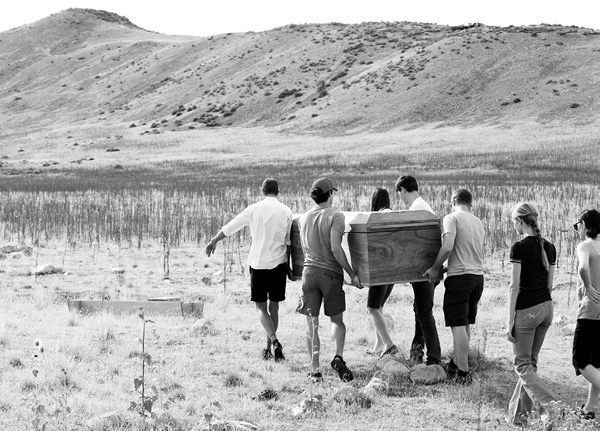
DRUM CASKET
first performed on August 1, 2013
Pine Box Rock Shop, Brooklyn, NY
performed 30 times in 2013
AMERY KESSLER
Mary Jane Ward
Ridgewood, NY
www.drumcasket.com
DRUM CASKET
AMERY KESSLER
“Drum Casket” is a ritualized event centered around the invented instrument, the Drum Casket. As a relational artwork, “Drum Casket” is a performance with participants simply being themselves, independent of a theatrical frame. As the name implies, the instrument is the marriage of casket and drum. People are invited to take turns individually lying inside or cooperatively drumming on the outside. In order to establish collective ownership and responsibility for the event, the group is given a set of instructions and parameters before beginning the successive drumming.
The Drum Casket is a birch plywood box measuring 84 inches long, 28 inches wide and 24 inches deep. The removable lid is stretched with a drumhead made from a single Bison hide. There is a five-inch hole in the drumhead above the face of the person lying inside. This porthole allows air in and out. Because there is no speaking during the event, the porthole creates an opportunity for a pivotal communication between the person inside and the people outside. The person inside reaches a hand through the resonating barrier when he or she has decided to get out, signaling the drumming to stop and allowing someone to take his or her place.
I created “Drum Casket” to be an intimate interaction based on the tangibility and evocative nature of a drum and casket. The Drum Casket is a physical, interpersonal interface. It provides a personal experience within a collaborative effort to be interpreted both actually and metaphorically.
For some people, the experience is an opportunity to consider the nature of self, human connection or mortality. For others, it is a release from the conscious mind and a surprisingly simple experience. By inherently eliciting and including many perspectives, thoughts and emotions, “Drum Casket” is a meeting place for personal perceptions to coexist and cooperate.
Because I have found that “Drum Casket” is best experienced in the context of a small committed group, facilitating re-occurring events has been the best way to include more people. To share the piece with nearly 400 people, my collaborator Mary Jane Ward and I developed the national tour of “Drum Casket.” We presented 30 events over the course of two months and 9,000 miles. The locations and settings included galleries, museums, schools and private homes, both indoors and outdoors.